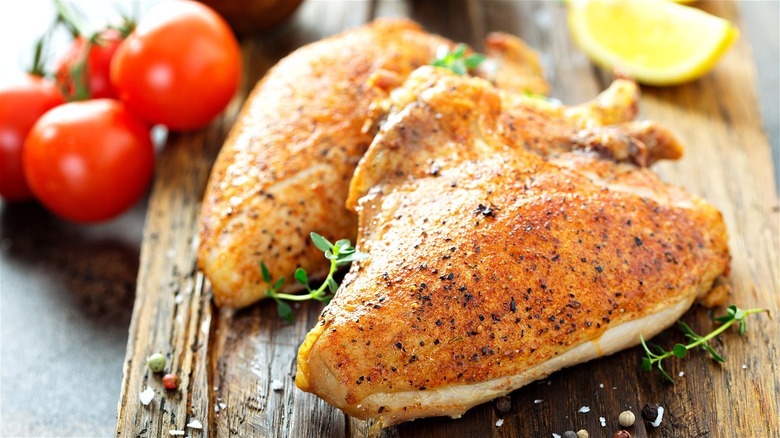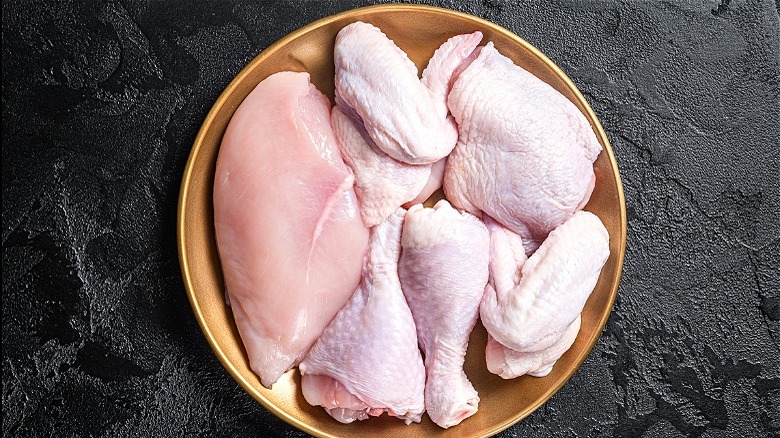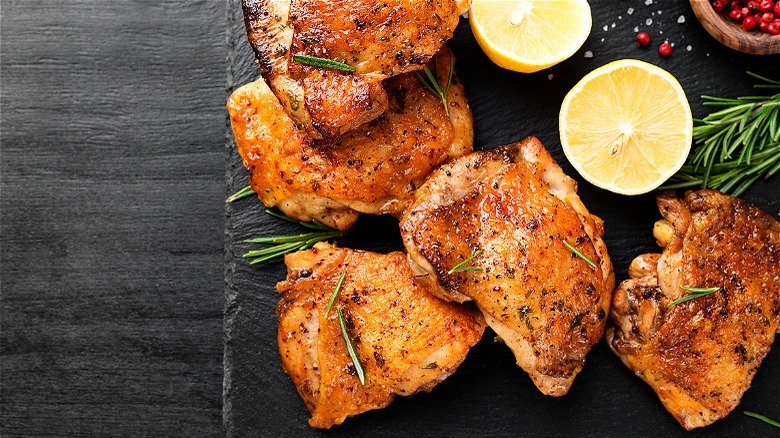Does It Actually Take Longer To Cook Skin-On, Bone-In Chicken?
If you're a regular meat eater, there's a strong chance you eat a fair share of chicken every week. What's not to like? Chicken is known around the globe as a versatile meat, able to take on a number of different seasonings due to its subtle taste. In fact, according to Bloomberg, chicken is on track to become 41% of the world's meat of choice by 2030.
As you prepare another grocery list to accommodate more popular chicken recipes for lunch, dinner, and everything in between, you probably have a certain type of cut you usually reach for at the supermarket. While you can buy either a whole bird or various chicken parts, such as wings and thighs, some cuts are more favored than others.
Based on a past Market Insights report from the USDA, boneless, skinless chicken breasts were the most popular choice next to drumsticks and thighs in 2017. However, when preparing chicken at home, whether you opt for a whole chicken or individual cut pieces, recommended cook times may be different. Yet when it comes to slight differences in the same cut, you may be curious to know if cook times still vary. If you're used to buying the boneless skinless variety but want to give bone-in skin-on cuts a try, will they take longer to cook?
Bones may impact the cook time of your chicken dinner
Whether or not you follow the ultimate ranking of chicken cuts, you probably already have a go-to cut of choice you regularly use for everyday meals. However, if you've been using boneless chicken breast, for example, and want to give the bone-in variety a try, you may need to plan on additional cook time. According to the USDA, poultry needs to reach 165 degrees Fahrenheit before consumption. But if you're opting for bone-in chicken breasts, they take slightly longer to cook, depending on your method of preparation.
Chicken.ca outlines the different styles of cooking and the time differences between bone-in and boneless varieties. Small, boneless chicken thighs, for example, take roughly 20 minutes to roast in the oven, while their bone-in counterparts take 35 minutes. If you're opting for chicken breasts, you need to roast bone-in cuts for at least five more minutes than you would boneless cuts. (White meat tends to cook faster, so you may not need to add too much additional cook time.)
If you don't want extra cook time but still desire something a tad different than boneless cuts, opting for boneless, skin-on pieces may be your best bet. The added layer of skin doesn't alter the overall cook time.
The most flavorful cuts of chicken
Now that you know the differences in cooking chicken with and without the bone, which is the tastier option? If you want to choose cuts of chicken based on flavor alone, many home cooks and professional chefs recommend opting for bone-in, skin-on cuts. The skin and bones tend to lock in moisture, keeping the meat juicy and tender. However, because the added bones increase the overall cook time, you might want to debone your chicken breast for elevated flavor the next time chicken is on your dinner menu. Leaving the skin intact provides an elevated flavor boost, even without the bones.
In fact, crispy chicken skin is known as a salty, savory treat for many foodies. To ensure you're on your way to perfectly crisped skin, make sure you always place room temperature chicken in a hot, oiled pan, and be judicious in deciding when to flip your chicken pieces. Give them enough time to brown by resisting the urge to flip too soon. While bones provide extra depth of flavor, you can achieve equally delicious results by opting for skin-on chicken cuts.
If you're still not ready to try something new but want flavorful boneless skinless chicken, opt for a recipe that ensures a juicy result. Oven-roasted chicken breasts prepared with brine and cooked with a meat thermometer ensure evenly cooked, moist chicken every time.


